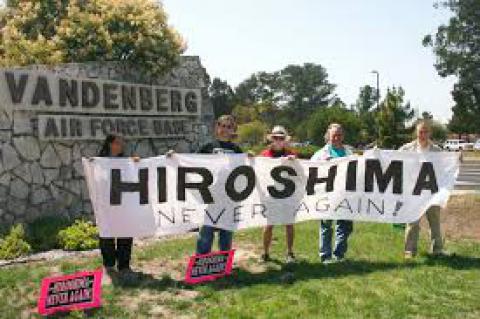
August 6 and 9 mark the 70th anniversary of the United States dropping atomic bombs on the Japanese cities of Hiroshima and Nagasaki. This mass destruction of civilians (not military targets, as President Truman alleged) has reverberated perversely across 7 decades, with the spread of nuclear weapons and the persistent pressure on Japan by the United States to abandon its post-war Peace Constitution.
After the first atomic blast, which killed 100,000 residents of Hiroshima immediately, the grievous radiation sickness of survivors was not anticipated nor was it believed when reported. Without any reconsideration, a second bomb was dropped on Nagasaki, killing 70,000 citizens outright. The American military censored all documentation and photo images of the two bombs’ unparalleled human devastation, sheltering Americans from the horrors of Japanese women, men and children instantly reduced to ash. Likewise, the post-war US occupying authority forbade Japanese citizens, under penalty of law, to own pictures of the atomic bomb destruction of both cities.
American military leaders from all branches of the armed forces, among them Generals Eisenhower, Arnold, Marshall and MacArthur; and Admirals Leahy, Nimitz, and Halsey strongly dissented from the decision to use the bombs, some before August 1945, some in retrospect, for both military and moral reasons. Japan was already defeated and in peace negotiations with the Soviet Union; surrender was imminent. A demonstration bombing away from residential areas (also supported by many atomic bomb scientists) could be used instead to force immediate surrender.
Dropping the atomic bombs launched an arms race in nuclear weapons, now possessed by 9 countries, with the ever-present specter of their use, an accident, or their theft by terrorists. Combined, these countries have some 16,000 warheads, of which 92 percent are held by the U.S. and Russia, now locked in hostilities over the Ukraine. In fact, serious conflicts fester in every region of the other nuclear nations: South and East Asia, the Korean peninsula, and the Middle East.
Since 1947 Japan’s post-war constitution has been known as the “Peace Constitution” because Article 9 of the Constitution “forever renounces war.and the threat or use of force as a means of settling international disputes.” Article 9 prohibits maintaining a standing military. Disputes over territory and oceans would be settled, according to Japanese legal experts, by diplomacy and use of police action.
Beginning with the Korean War and successively with the perceived threats of the former Soviet Union, Iraq, and now terrorism, the United States has exerted pressure on Japan to scuttle Article 9 and join in US military operations. On April 27, 2015 Japan’s ultranationalist Prime Minister Shinzo Abe, who prizes Japan’s militaristic past, signed a defense agreement with the United States and subsequently addressed the US Congress, without consulting the will of his people. The agreement commits Japan to join US military operations anywhere in the world, in violation of the Peace Constitution according to virtually all Japanese constitutional scholars. Further, recent public opinion polls show that the majority of the Japanese people oppose the erosion of their Peace Constitution and the new defense policy leading to perpetual support of the US military by Japanese military.
Japanese politicians, who are gutting their Peace Constitution, were born after World War II “and so they don’t understand that war must be avoided at all costs,” remarks Kaname Harada. Harada was one of the most feared and daring of WWII pilots and admits that he still sees the terror in the faces of US pilots whom he sent to their death. “War robs you of your humanity by putting you in a situation where you must either kill perfect strangers or be killed by them,” he says; and he vows to tell audiences what he saw in war, until he dies. “Never forgetting is the best way to protect our children and our children’s children from the horrors of war.”
For the 10th consecutive year, the US Conference of Mayors unanimously adopted a resolution calling for the United States and other nuclear-armed countries to eliminate nuclear weapons and redirect nuclear weapons spending to meet “the pressing needs of cities.” Unlike Washington Beltway politicians, mayors live in their cities and see up close the contrast of a massive military and nuclear weapons budget with a minimum wage that is not a livable wage. In their June 2015 resolution, they called for redirecting $348 billion earmarked for modernizing our nuclear weapons over the next 10 years to investing in a just and sustainable economy, infrastructure and environment.
Pick your issue of human suffering and insecurity-the 22 percent of US children living in poverty, underemployment, homelessness, climate change, human trafficking, high school dropout rates-and imagine what our taxes targeted to modernize nuclear weapons and police the world militarily could do invested in a peacetime economy.
[Pat Hynes, former Professor of Environmental Health at Boston University School of Public Health, directs the Traprock Center for Peace and Justice in western Massachusetts. https://newsite.traprock.org ]
– See more at: http://www.portside.org/2015-08-04/august-6-and-9-1945-reverberations-across-seventy-years#sthash.qMfnRjqJ.dpuf